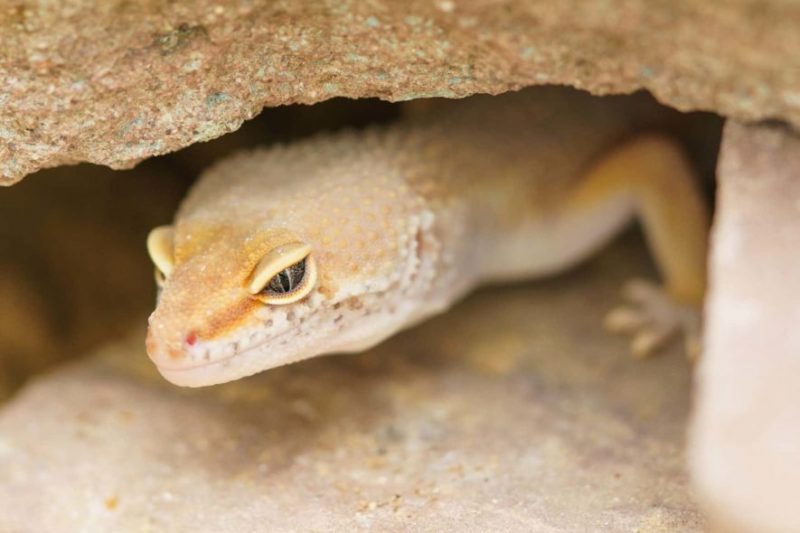You’ve probably heard that:
- Leopard geckos are popular as pets
- Leopard geckos are named after their spots
- Leos need some special care and diet
But, did you know that:
- Leopard geckos are among the most popular pet reptiles in the world, and with a good reason
- Leos come in an amazing variety of colors and patterns thanks to morphs that have been developed in captivity.
- Leos are easy to care for and require less space and equipment than many other lizard species
I have spent the last 14 years in the company of leopard geckos, and they have been the most satisfying pets I’ve ever had. The amazing color range, the docile temperament, the unique characters, the seemingly-smiling faces, the fact that they are undemanding, hardy, easy to care for and breed – these are the traits that make leopard gecko a great pet, and a joy for every reptile enthusiast.
That is the reason that leo is such a popular beginner lizard, but also a favorite of many seasoned leopard gecko breeders, some of which dedicated their entire careers to these charming, easy, and sometimes even squeaky mini-dinosaurs.
Some Facts About the Leopard Gecko
- Leopard gecko’s natural range spans through parts of the Middle East, central and southwestern Asia.
- Although in captivity they are usually kept in desert-type terrariums, leos are not desert dwellers, and sand is not a good substrate for them.
- The scientific name for Leopard gecko is Eublepharis macularius.
- Leos are often referred to as nocturnal, but they are actually crepuscular animals, which means they are most active in twilight.
- Leopard geckos lack the adhesive lamellae – microscopic hooks on their feet that most others geckos have; that means they cannot climb vertical surfaces.
- Since leopard geckos breed so readily in captivity, almost all available leos on the market were born in a terrarium.
- Leopard gecko’s natural color is yellowish-brown with dark spots all over the body. However, many morphs with amazing color ranges were created, and many of them don’t include any spots.
Lifespan: How Long Do Leopard Geckos Live?
For a small animal, leopard gecko is pretty long-lived. Their lifespan depends on the care and breeding, but it can span from 8 years for breeding females up to 20 years for males or females that haven’t been bred. The oldest known leo lived up to be 32 years old.
Size: How Big Can Leopard Geckos Get?
Leopard geckos length ranges from 7 to 8 inches (~18-20 cm) for females and 8 to 10 inches (~20-25 cm) for males. They are small to medium-sized, but sturdily built lizards.
However, there are bigger and heavier leo morphs called Giant and Super Giant, weighing up to 150 grams, or even more.
Difficulty: How Is the Leopard Gecko Behavior?
In short, leopard geckos are easy-going lizards. They are not overly fast, and they are absolutely non-aggressive. Aside from the attractive looks, it’s their temperaments that make them such popular pets.
Although leos are not social in the true sense of the word, they do communicate with their surroundings and other members of their species. They have specific body language and utilize their tails to communicate, and sometimes they even vocalize. Learning these cues will tell you a lot about your leo’s mood and health. Here are several examples:
- Tail waving basically has a role to inform others of the gecko’s presence; male will wiggle his tail to introduce himself to females, and more vigorous shakes have a defensive role.
- Tank (glass) climbing can be a random exploration activity, but can also indicate that something’s off with your gecko’s environment.
- Squeaking or chirping usually translate as “stay away”, or “let me go”; some geckos will also vocalize while in pain, so check them if they are making sounds without any contact.
As I mentioned, leo’s behavior provides an insight into their health status. Like other animals, leopard geckos can get hurt or sick, although with proper care this is very rare.
Some commonly seen leopard gecko health issues include:
- Intestinal impaction;
- Incomplete shedding;
- Vitamin and mineral deficiency
- Metabolic bone disease;
- Parasite infections;
- Egg retention – dystocia;
- Wounds, burns and abscesses;
For a full checklist and detailed descriptions of common leo health problems, please refer to our main article on health and diseases.
> Read More: The Leopard Gecko Behavior & Health
The Type of Habitat
Although leopard geckos come from dry grasslands of Asia, in captivity they typically live in desert terrariums – with one big exception. Sand should never be used as a substrate, as it can cause bowel impaction when accidentally consumed with food. The predominantly dried habitat which features suitable rocks and smooth pebbles, or other type of suitable substrate, at the bottom of the tank is perfect for satisfying leo’s natural needs.
Leos should also have several hiding places (at least one per gecko, but more is preferable), and at least one of them should feature absorbable substrate which you will keep moist – peat moss, coconut coir or other types of “eco earth”. Note that these are not suitable as general substrate, but only for moist hiding boxes.
The minimum size of the tank should be 10 gallons (~ 40 liters) for a single leo, and 15 gallons (~ 60l) for a pair; as a general rule, you should add 5 gallons for every additional gecko.
The temperature in the tank should be between 75° to 85°F (~ 24-29 °C) during the day, with the basking area featuring temperature up to 90°F (~ 32 °C). The tank should be arranged in a way that allows a temperature gradient – when there is one heated area in the higher temperature range, while the opposite area should be cooler. You will provide additional heat to the tank by using heating pads, ceramic heaters or suitable lights.
Being crepuscular, leopard geckos have adapted to live in the relative darkness. That means that a UVA/UVB specialized reptile light is not necessary for your leo to thrive. In fact, if the room is well lit, leos will thrive without any artificial light. The only thing that is important is for them to have their day-night cycle.
> Read More: The Leopard Gecko Habitat
Diet: What Do Leopard Geckos Eat?
Leopard geckos are insectivorous lizards – they will eat only insects, and will accept live insects only in most of the cases. That may sound troubling, but fortunately, feeder insects are easily reared at home, can be ordered online, and are probably available at your local pet store.
Some examples of feeders from leopard gecko’s menu are mealworms, crickets, superworms, dubia roaches, and waxworms. As I said before, all of these insects can be bred in your home with relative ease.
Leos food will have to be regularly dusted with a specialized reptile multivitamin and mineral powder. They will also require some source of pure calcium in their tanks.
Leopard geckos drink water quite often, so you need to provide fresh water in shallow trays within their terrarium.
> Read More: The Leopard Gecko Diet
Availability: Where to Buy a Leopard Gecko and What Is the Cost?
Leopard geckos can be bought in a pet shop, directly from a breeder, or at reptile shows.
Although buying a gecko at a pet store seems easier, I would always recommend buying your pet from a reputable breeder. You can’t know what was the store-displayed gecko’s quality of life up until you saw him; how he has been fed, how stressed he was, and both of these factors can impact his health. I heard about cases of leoopard geckos bought in a pet shop that refuse to eat in their new home.
A reputable, quality breeder should be comfortable with showing you all his reptiles, facilities, and breeding terrariums. An ideal breeder will readily advise novice reptile enthusiasts and will be more than happy help you pick a healthy gecko.
If you are a child reading this, know that you should always bring your parent or a guardian to help you with your choice. In fact, it’s good to have a reliable company when buying a pet no matter what’s your age, as two objective pairs of eyes will see things clearly much better than just one.
The price largely depends on the morph. You can get a “normal”, wild-type leopard gecko or gecko with a common morph for around 20$. Expect to pay around 100$ for more exotic morphs. The rarest morphs, such as the Black Pearl, can cost up to a couple of thousand dollars.

Leopard Gecko FAQ
Why Leopard Geckos Make Good Pets?
Leopard geckos make excellent pets – they are easy to care for, hardy, attractive and quite charming in their own way. They don’t require a lot of space or special equipment. Although they eat live insects only, the diet doesn’t have to be highly specialized and are not fussy eaters.
They also have quite long life spans (see below), which makes them suitable to have if you have children – by the time your pet’s time to go comes, they will be mature enough to handle the concept of death.
Do Leopard Geckos Bite?
Leopard geckos are not aggressive, and a large majority of adults will not bite even when they feel threatened. A young gecko that is not used to handling will be more prone to snapping than a tame adult.
If it happens that you get bitten by a leo, it will be by accident – when they mistake your fingers for food (especially if you hand-feed), or if two of your lizards have a fight and you try to separate them.
Leos have tiny teeth that are dangerous only for insects. However, their jaws are strong for their size, so the bite reminds of a hard pinch rather than a real bite. In most cases, it will only scratch the upper layer of your skin.
In case you get bitten by your pet gecko and the bite pierces your skin, be sure to disinfect the “wound” properly. Be especially careful about the thin skin just above your nails, as, in my experience, is the only spot that will bleed in the case your gecko gets it.
How to Tame a Leopard Gecko?
Captive-bred leopard geckos might be more docile than the wild-caught specimens, but they still have their natural defensive instincts. Each gecko needs some time to become tame – to get used to being regularly caught and handled by humans.
Taming a leopard gecko includes several phases:
- First, you will put your hand in the tank without catching the gecko.
- As he gets used to this, you will start to hold him gently for a short moment, and then let him go.
- When your leo lets you hold him for a prolonged period of time, you can carry him, but still without taking him out of the terrarium.
- The last step is taking your gecko out of the terrarium. Make sure you are holding your lizard above a soft and wide surface, such as a big bed.
To prevent escape and injury, probably the most important rule is not to put your leo out of his tank until you are sure that he is completely comfortable and relaxed in your hands. Just go easy – if your leo is squeaking and trying to wiggle out, let him go and stop the session.
Note that juveniles tend to be nervous and snappy, so go slowly with them. As they get more mature, it will be easier and safer to practice handling.
Do Leopard Geckos Yawn?
Yes, leopard geckos really do yawn, and that is one of their more amusing displays. They are known to do it after meals, but in my experience, they will also do it randomly during their active period of the day.
Do Leopard Geckos Smell?
Leopard geckos are odorless – if you keep their terrarium neat, of course. Since they eat only insects, there are no food residues that can get moldy, and their excrement is granular and dry.
The only thing that can be smelly and is related to geckos are the feeder insect colonies. Because of the smell and also the ammonia vapors, make sure to keep them out of your bedroom or living room.
Do Leopard Geckos Dig?
Leopard geckos will dig in two cases. A pregnant female will get an urge to dig as she is getting ready to deliver eggs; she may dig around the tank more than usual if she doesn’t have a proper nesting site. In other cases, leos will dig if as a part of their burrowing instinct. Digging can be intensified in the case their moist shelter got dry, or if they don’t have a sufficient number of hiding places.
Do Leopard Geckos Make Noise?
Leopard geckos can and will vocalize on different occasions – they can squeak or yelp quite loudly for a small lizard.
Do Leopard Geckos Change Color?
Leopard geckos cannot change their pigmentation as chameleons can. However, their color will change as they are getting ready to shed their skin. As the old skin is prepared to be removed, it will get pale, making your gecko look ghostly.
After they shed their skin, the new skin will have a normal color. In fact, it will even look fresher and brighter for a while.

How Many Leopard Geckos Can Live Together?
Leopard geckos don’t live in packs. Even if cohabitation can work in specific cases, one of your leo behavior can change from a day to another. This can result in injuries or worse. It is never a very good idea to keep two leopard geckos together.
If you have several leos, they can still meet occasionally outside of their respective tanks, in neutral territories. Keep an eye open to see if everything goes well!
Do Leopard Geckos Get Lonely?
Leopard geckos are solitary animals. A large majority of reptiles are not very social creatures, so as far science can tell at this point, they can’t get lonely. If you do not have the space to keep two or more leos, you don’t have to worry if your single leo will get lonely – because he will not.
On the other hand, although they won’t get exactly emotional about it, leos will surely suffer if an owner ignores them, and fails to feed them, change water, or clean their tank regularly. Since they are really discrete and undemanding pets, they can get easily neglected. Be sure to check on your gecko and cater to his needs every day.
How Many Leopard Gecko Morphs Are There?
Believe it or not, there are more than one hundred leopard gecko morphs and color variations. The number is increasing with almost every breeding season. Some popular morphs include Tangerine – featuring orange hues, Blizzard – patternless albino with light pastel overtones, High Yellow – with generous amount of bright yellow color on its body and reduced spots.
> Further Reading: Our Ultimate Guide on Leopard Gecko Morphs
When Is a Leopard Gecko Full Grown?
All reptiles grow through their entire lifetimes. The same is with geckos, but the rate of growth drastically changes after they turn one year old. Up until then, they will grow rapidly, and you can say that they will reach their full size at one year old. The growth that goes on later is minuscule.
I hope that after reading this overview you have the basic knowledge about leopard geckos and a clearer idea if the famous leo is a pet for you. Doing research and gathering information before buying a leopard gecko is crucial for having a happy and healthy pet.
For even more in-depth information on health, behavior, diet, and habitat, please feel free to explore our other articles.
Do you have anything to add or anything to ask? Let us know in the comments! Ultimately, keeping the conversation going and exchanging experience will benefit our beloved leopard geckos the most.













42 Comments
It says that the minimum tank size for one is 10 gallons. That info is outdated it has been 40 gallons for at least 2-3 years or so. They’re also solitary and can not be kept together. I rescue and I’ve seen some horrible horrible things with cohabitation. And definitely no heating pads. Overhead heat only! Like the sun.
It does state later in the article that cohabitation is a good idea, but in the beginning it says it’s okay. So just probably an honest mistake!
I’m constantly every single day doing research on these critters. And I plan on becoming a herpetologist at some point!
Hi Alexis,
Thank you for your comment and for pointing out these facts. The best-practice recommendation is 40 gallons, but 20 gallons is also tolerable in my experience. I, too, prefer overhead heating, but some people still prefer heat pads because they believe belly heat enhances digestion. In nature, the ground and the rocks also heat up and radiate the heat from below, so it is not really irrational to provide it, and there is no proof that these heaters are harmful (except the cheaper ones are prone to burning – yikes).
You might be happy to learn that we are in the middle of updating all our articles to comply with the latest keeping recommendations, so stay tuned. And good luck with your herpetology ambitions—I fully support them!
Hi!
I just got my leopard gecko a little while ago. Do you have any tips for a young teen for me. Like how often should i clean there tank, and can i use 2 lights (A uvb for uv basking and a heat for heat basking.) If you can it would be a big help.
Thank you.
I know it’s a long read, but please try to read through the entire care sheet – pretty much everything you want to know is in there. People often make grave mistakes out of a simple lack of information, despite their good intentions. As for the light question, some leos bask, some don’t, but it is not mandatory for them like for other day lizard species.
Although a UV lamp is still not considered a must for leopard geckos, it is surely better to have one. UV lights are always combined with a regular basking light and you should keep them on at the same time, yes. Depending on the manufacturer, the UV bulb should be replaced every 6-12 months. Make sure to follow the proper day-night schedule (12-14 hours of daylight. Oh, and lights aside, don’t forget about gut-loading feeder insects and supplementing with quality multivitamin and pure calcium powders. Good luck!
Hello, so I just got my first leopard gecko and I need some care tips. What should I do for the lighting/heat. I am currently using a red light all day (I have heard I have to switch it at night but I do not have another light bulb).
If you could also provide some more tips for basic care like how bright it should be, how much food per day, etc. It would be a big help.
Hi Westin,
I’ve just replied to your other comment. Please read the care sheet, I promise everything’s in there 🙂
If the night temperature in your room doesn’t drop below 70 degrees F, you don’t need nighttime heating. In fact, it’s recommended that you let the nighttime temperature drop up to that point so your lizard’s body can rest properly. Make sure to use a thermometer in your tank so you could know precisely if your leo might be too hot or too cold.
Daylight bulb such as halogen or incandescent, in combination with the UV you mentioned is an excellent combination for the daytime. For additional or nighttime heating (the thermostat will tell you if you need it), you can use a Ceramic Heat Emitter, which looks like a bulb but doesn’t give off any light, just warmth, or an undertank heat mat. You don’t need the red light at all – it can disturb your gecko during the night and it is unnatural for them and is said to distort their vision during the day.
So it says never put 2 Leo’s together? However, I’m buying a huge set up with 2 Leo’s (from a family who is moving and can’t take them with) in a couple days and he told me he didn’t want to separate them. He said they’re 3 and have lived together their entire life. He also said that they are so adorable together and they even sleep in a snuggle pile♡. Should I have any concerns?
Also, read an article that you should never ever ever use wood chips or any wood, but his set up is a massive (40/50g?) tank with huge layers of slab rock around sides and back perimeter and, you guessed it, wood chips along the bottom and several big bark hides. Would you recommend I change this?
Thanks for the helpful info!!
Like Megan, I also have you bookmarked on my phone’s screen😂
Hi Kimi,
We’ll take that as a big compliment! Thank you for your trust – we’ll do our best to keep it 😉
Hi Kimi,
I understand your reluctance and sentimentality, but avoiding cohabitation (not housing leos together) is an official recommendation in every responsible care sheet and literature piece on leos. Although they may seem adorable sleeping together (yes, they do that! But probably not out of being emotional, but due to simply preferring the same hide at the moment :)), they will certainly bite each other at some point – it’s almost unavoidable. This can pass with no injuries, or the injuries can be debilitating – it’s a matter of luck. On the other hand, according to what we know about leos at this point, separation wouldn’t take any known toll on them.
While I’m writing this, I suppose that both leos are females – in any other case (two males or male and female pair), they should be separated immediately, no matter how cute they look together.
If you still choose to keep them together, cohabitating, be aware that you’re doing it at a risk, and you have to take certain precautions – first of all, to ensure they ALWAYS eat separately (that’s when most conflicts and physical fights occur). And again, you’re taking personal responsibility for it.
As for the second issue, I’d recommend changing the wood chips for some of the recommended leopard gecko substrates. Bark hides are fine, but smaller wood particles such as wood chips can definitely cause more harm than good.
Good luck with the setup and thank you for commenting!
I have a beautiful 6 month old female gecko. We love her but the past 6 days she won’t eat much. Maybe a couple crickets and a couple wax worms, she wants nothing to do with her mealworms all of a sudden. Her tail is still fat so she seems healthy, just not that hungry, any suggestions as to why she’s gotten so picky.? And what can or should I do to entice her?
Hey Libby! Sorry to hear that your gecko isn’t eating well. There could be a few reasons for this – maybe she’s stressed from moving to a new home, or the temperature in her tank isn’t ideal. If she’s been sick recently, that could also affect her appetite.
There are a few things you can do to try and get her to eat more. Make sure she has a warm, comfortable place to hide, and that the temperature in her tank is around 75 to 85°F. You can also try offering her a variety of different food items, to see if she’s just being picky. Some geckos like to eat live food, while others prefer pre-killed or frozen/thawed.
Hi
Do leopard and crested geckos need UVB light?
If so, how long is the light needed for?
Can they live in a Summer house or shed outside?
Thanks
Abi
Hi Abi,
You can find answers in the following articles:
– https://www.terrariumquest.com/leopard-gecko/habitat/best-lighting/
– https://www.terrariumquest.com/leopard-gecko/shedding/
I’ve always heard you cannot put leopard geckos together under any circumstance, and you need 20 gallons per gecko, but I have seen so many articles like this one. Is this actually true?
As with every other aspect of reptile maintenance, different keepers embrace different practices. Typically, female leopard geckos will cohabitate peacefully, as will male-female pairs (although you do need to ensure the male doesn’t pester the female with constant breeding attempts). Mature males, on the other hand, will often fight if placed together.
Nevertheless, it is often wise to simply err on the side of caution and keep leopard geckos separately to avoid any problems. It simply depends on how risk-averse you are.
Personally, I’ve kept female leopard geckos in groups of four many times without issue.
As for the space question, 20 gallons is likely sufficient for two leopard geckos. But it’s almost always wise to provide the most space you possibly can for your pets.
Best of luck!
I am trying to convince my mom to let me get a leopard gecko. I know that the prices range by the type of leopard gecko but I don’t know which type I should get? Any ideas which type would be best for a beginning teen like me?
Hey, Ian.
No question about it, the most important thing you should focus on is buying a healthy pet from a reputable breeder. The color morph you choose is largely a matter of budget and personal taste.
Best of luck convincing mom!
Can I keep a 6-month-old leopard with a baby house gecko?
Hey, Courtney.
That’s probably not a good idea – house geckos and leopard geckos hail from different habitats and require different captive conditions. Plus, most house geckos are going to be parasitized, and he may transmit worms or protozoans to your leopard gecko.
Thanks for reading the site!
Hey, Courtney.
I think I answered you elsewhere, but that’s not a good idea. House geckos and leopard geckos require different captive conditions.
Thanks for reading the site!
What about water? Do leopard geckos like water? Should I somehow bathe him? Fine time for me to ask, he is already 20 years old…but in good health.
Hey, Cindy. A 20-year-old leopard gecko is impressive!
Leopard geckos need water for drinking, but they usually don’t need regular soaks or baths unless they are seriously dehydrated or experiencing a rough shed. An occasional brief soak in about 1 inch of lukewarm water probably won’t cause any harm, but it’s probably not necessary either.
Thanks for reading!
I cant decide wheather to get an African fat tailed gecko or a leo. I know how to care for bothe species.
what reptile do you think is best out of these two geckos for a 14 year-old?
thanks.
Hey, Jacob.
I think they’re both super-cool species, and you should be able to have success with either. If you’re interested in breeding your pets, I’d recommend going with the leopard geckos, as there are more color mutations available. However, if you’d rather keep a lizard that isn’t as common as the ubiquitous leopard gecko, a fat-tailed gecko would be a great choice.
Honestly, you’ll likely enjoy keeping either species, so just pick the one that makes you happiest.
Best of luck! Let us know which one you pick!
Can I keep a Leo and a crested in the same tank say 20 Gal size
Hey, Maggie.
Sorry, but no – that wouldn’t be a good idea. They have different habitat requirements.
Thanks for reading!
No
We have a 4 week old leopard gecko. The PetSmart folks told us to put a dish of calcium in there, so we did. This is actually our Leo’s favorite place to sleep. Should we be concerned?
Hey, Marisa.
These lizards certainly can do some weird things from time to time. But I wouldn’t worry about it. Just make sure that your pet has a nice, dark hiding place to use if he prefers.
Best of luck!
How do I set up a good tank for my albino leo? He is a rainwater albino and I want to set up a realistic habitat, but not one that will damage his eyes.
Hey there, Katelyn.
Even normal leopard geckos are pretty averse to bright lighting, so there’s not much I would recommend doing differently. It would probably be wiser to simply avoid using lights entirely, and instead opt for non-light-emitting heat sources. Also, as always, provide your pet with plenty of good, dark hiding places.
Best of luck!
My Gecko has scratched a sore on top of his head. He did it once about 6 months ago and I made him a bath with a little iodine in it. That did seem to help but now he is doing it again. Could it be parasites or something else?
Just bought my son his first gecko last week. She is stressing me out . I’ve read so many articles and spoken to several ppl on how to care for her. The last thing I want is for her to die.
I realized the bright bulb was too much for her so I bought a red bulb. After reading this I realized i should cut it off at night. Which Petco didn’t tell me. Also we’re still trying to get her to trust us. she stays in the cool hide all the time. Rarely go into the hot hide. I thought she needed that to digest her food. Petco told me not to get the moist hide just spray the tank with water 2x a day.
I want to take her back but my son refuses. He’s not giving up on her.
Hi Tina,
We got our 1st Leo from Petco too. We’ve had him since December 26th. For every person you talk to at these places, you will get a different answer! We know have 2 leopards! Each has their own terrarium. Our big guy (Bendy) is in a 20g long and our baby (Tangerine) is in a 10g. The lights have caused us the biggest stress! But we think we finally have it figured out and they both seem to be very happy and thriving! In Bendy’s home, we use a 75w basking light over one of his hides during the day. He has a cool side to escape too! We found a 75w night bulb, that mimics the moonlight, but still provides him warmth! Since Tangerine’s home is much smaller, we kept the standard 60w day/heat bulb and we use the same night bulb for her.
As far as the moist hides, we kind of made our own. You can use moss in one corner of their warm hide and spray it to keep it moist. Some people I know also use a plastic Tupperware like container and cut the side for them to go in and out, but put moss in it for them to have a moist hide and place to go shed.
I also recommend having spare bulbs as back up, just in case one burns out!
It can be a little overwhelming at first, but it is worth it! We love our Leo’s and we feel they like us too!
Feel free to email me if you have any questions or would like to see our setup!
Hi, I’m wondering about a large shallow bathing area. It doesn’t seem to be a common thing and maybe I’m just humanizing ours? If not then is there a maximum/minimum water container for them?
Hey Nilda, It’s not common, but leopard geckos can certainly benefit from a large, shallow water dish! There is no maximum or minimum size for the water dish, but it should be large enough for your leopard gecko to comfortably soak in and shallow enough that they can easily get in and out. Thanks
This gave me just enough info on my gecko. My uncle had her for 5 years and gave it to me because he couldn’t take care of her anymore because he has a newborn child and a toddler now. So this gave me a lot of very good info. Thank you
TerrariumQuest.com is simple, well organized and non-overwhelming. I like that it has interesting and helpful info coming from kind scientists. I really wish I’d found it a couple months ago because it would have saved me money and tons of energy! I’ve felt exhausted and confused and I’m broke!
As I’m just starting to care more for my leopard gecko after being neglectful and causing her stress, which likely lead to a new health issue, finding such a straightforward, accurate website would have felt like a miracle. Also designing her terrarium seems less daunting before I read your section on set up. If Petsmart would just write your web address on the front of their reptiles’ tanks, there would be more happy, healthy critters.
It makes me angry that pet stores sell long lived Leos and stock up on overpriced, sometimes dangerous, low end supplies. Then they leave out some incredibly important items altogether. Keeping animals happy is an awesome way to experience joy in everyday life and my girl is a sweet and simple pet. She’s so fun to look at! Additionally designing the tank is a great creative challenge. It’s soothing to the soul. I saved your site on my cell phone’s home screen. Sorry about the rant. Thank you:)
Hi Morgan,
Thank you for this nice comment! I’m glad that you see the website this way because it is exactly what we are trying to achieve here.
I’m very glad our articles are helping you and your leo. I wish her a long and comfortable life and I wish you happy moments with her.
Please don’t hesitate if we can be of any help 🙂
One subject that was not mentioned was to whether there was a chance that the male or female would eat their own babies after they had hatched? Is it safe to leave the hatchlings in the same cage with the mother or is it best to separate them entirely?
Hi Eileen,
Thank you for your question, especially since it is a useful one. You are right – I haven’t directly addressed the issue in this article, although the right conclusion could be drawn from our Leopard Gecko Breeding article.
Here is the answer: Lizards will typically try to subdue and eat any living creature smaller than themselves – and that, unfortunately, includes their own offspring. In nature, leopard gecko’s menu includes an occasional smaller gecko or other lizards. Although it is not in their (evolutionary) interest to eat their offspring, lizards lack social instincts and parental care – they can’t really make a difference between their own and somebody else’s babies.
That is why hatchlings and juveniles of any lizard species – leopard geckos included – should be kept and raised separately from their parents.
In fact, any two lizards that display a significant difference in size should be kept separately to avoid triggering a predatory attack. The same goes for juvenile siblings if they start to grow at different rates.
If you are interested in breeding leopard geckos and hatchling care, I suggest you check out our special breeding article:
https://www.terrariumquest.com/leopard-gecko/breeding/
Good luck!